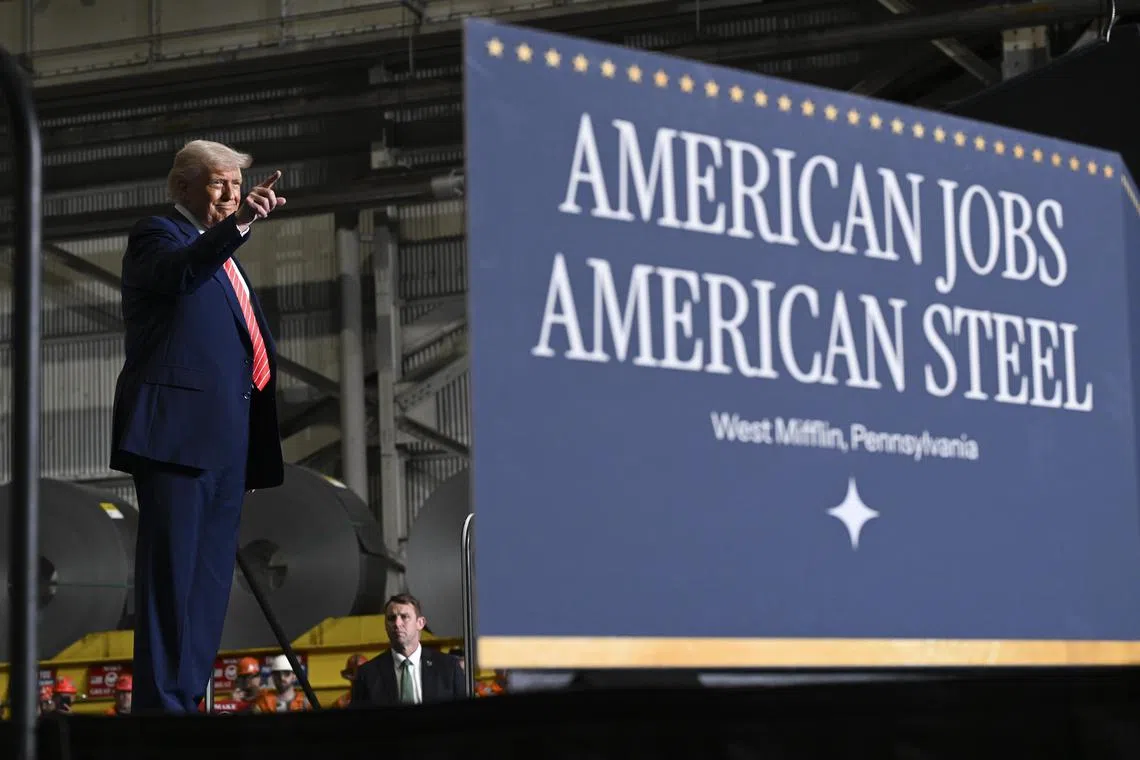Trump says he plans to double steel, aluminium tariffs to 50%
Sign up now: Get ST's newsletters delivered to your inbox

US President Donald Trump said the increased tariff would take effect on June 4.
PHOTO: KENNY HOLSTON/NYTIMES
Follow topic:
WEST MIFFLIN, Pennsylvania - US President Donald Trump said on May 30 that he planned to increase tariffs on imported steel and aluminium to 50 per cent from 25 per cent, ratcheting up pressure on global steel producers and deepening his trade war.
He added at a rally in Pennsylvania that the increased steel tariffs would even further secure the steel industry in the US.
Mr Trump announced the higher tariffs just outside Pittsburgh, where he was talking up an agreement between Nippon Steel and US Steel
He said the US$14.9 billion (S$19.2 billion) deal, like the tariff increase, will help keep jobs for steel workers in the US.
He later posted on social media that the increased tariff would also apply to aluminium products and that it would take effect on June 4.
Shares of steelmaker Cleveland-Cliffs Inc surged 26 per cent after markets closed as investors bet that the new levies will help its profits.
The doubling of steel and aluminium levies intensifies Mr Trump’s global trade war and came just hours after he accused China of violating an agreement with the US
Canada’s Chamber of Commerce quickly denounced the tariff hike as “antithetical to North American economic security”.
“Unwinding the efficient, competitive and reliable cross-border supply chains like we have in steel and aluminium comes at a great cost to both countries,” Ms Candace Laing, president of the chamber, said in a statement.
Australia’s centre-left government also condemned the tariff increase as “unjustified and not the act of a friend”.
“They are an act of economic self-harm that will only hurt consumers and businesses who rely on free and fair trade,” Trade Minister Don Farrell said in a statement.
Australia, a key US security ally in the Indo-Pacific, would “continue to engage and advocate strongly for the removal of the tariffs”, he added.
Mr Trump spoke at US Steel’s Mon Valley Works, a steel plant that symbolises both the one-time strength and the decline of US manufacturing power as the Rust Belt’s steel plants and factories lost business to international rivals.
Closely contested Pennsylvania is also a major prize in presidential elections.
The US is the world’s largest steel importer, excluding the European Union, with a total of 26.2 million tonnes of imported steel in 2024, according to the Department of Commerce.
As a result, the new tariffs will likely increase steel prices across the board, hitting industry and consumers alike.
Steel and aluminium tariffs were among the earliest put into effect
The tariffs of 25 per cent on most steel and aluminium imported into the US went into effect in March, and he had briefly threatened a 50 per cent levy on Canadian steel but ultimately backed off.
Under the so-called Section 232 national security authority, the import taxes include both raw metals and derivative products as diverse as stainless steel sinks, gas ranges, air-conditioner evaporator coils, horseshoes, aluminium frying pans and steel door hinges.
The 2024 import value for the 289 product categories came to US$147.3 billion, with nearly two-thirds aluminium and one-third steel, according to Census Bureau data retrieved through the US International Trade Commission’s DataWeb system.
By contrast, Mr Trump’s first two rounds of punitive tariffs on Chinese industrial goods in 2018 during his first term totalled US$50 billion in annual import value.
REUTERS

